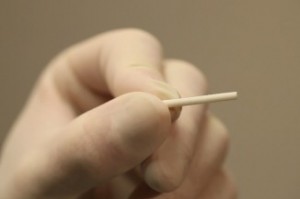
After the Food and Drug Administration (FDA) decided last year not to approve implantable buprenorphine to treat opioid abuse, researchers have begun a new study to address the agency’s concerns about the product, called Probuphine.
The study will compare Probuphine to buprenorphine/naloxone which is taken under the tongue. Approximately 190 patients are being enrolled in the study at about 20 sites around the country. They will be randomly assigned to receive either an implant of Probuphine in the upper arm, along with placebo tablets under the tongue; or a placebo arm implant, along with buprenorphine/naloxone tablets. Probuphine implants are designed to be effective for at least six months.
The study participants are people treated for opioid dependence who have been stable while taking buprenorphine/naloxone for several months, without using any illicit opioids, says Frank Vocci, Ph.D., co-principal investigator.
Participants will be checked 10 times during the six months of the study to find out if they are using illicit drugs. At the end of the study, the researchers will determine whether there is a greater than 10 percent difference in response between the two groups. “If Probuphine is superior to buprenorphine/naloxone, that’s fine, but we don’t want it to be more than 10 percent worse,” says Vocci, who is also President of the Friends Research Institute, and Past President of the College on Problems of Drug Dependence (CPDD). He spoke about the new study at the recent CPDD annual meeting.
The treatment will be considered successful in a participant if there are no more than two months in which a participant has a positive urine opioid test, Vocci said. The design of the trial was negotiated with the FDA after the agency declined to approve Probuphine.
Probuphine has several advantages over buprenorphine/naloxone, Vocci notes. Because it is implanted in the arm, it would be extremely difficult to divert it and sell it on the street—a major drawback for buprenorphine/naloxone sublingual tablets and strips. It also would be a safe alternative for patients who have small children, eliminating the concern about accidental poisoning with tablet forms of buprenorphine/naloxone.
An implant would also make it simpler for patients who travel. “They don’t have to take their medicine with them or worry about running out,” Vocci said.
When the FDA rejected the New Drug Application for Probuphine last year, it cited concern about what the correct dose should be. This new study is designed to address the question of whether four implanted rods of 80 milligrams each over six months is equivalent to 8 mg or less of daily buprenorphine/naloxone.
The current study is only looking at Probuphine’s effectiveness for six months. If the FDA approves the drug, the agency is likely to ask for studies of its effectiveness when people receive two, three or four consecutive six-month implants, Vocci said.
Doctors authorized to prescribe buprenorphine/naloxone currently can only prescribe it for up to a maximum of 100 patients. Vocci says that it is possible that if Probuphine is approved, the Substance Abuse and Mental Health Administration could lift the patient limit for the implantable drug. “When the 100-patient limit was imposed, it was based on concerns that physicians wouldn’t be trying to take care of too many patients at once, and to limit the issue of drug diversion,” Vocci observed. “With Probuphine, that shouldn’t be an issue.”
Published
September 2014
 Get Support
Get Support
